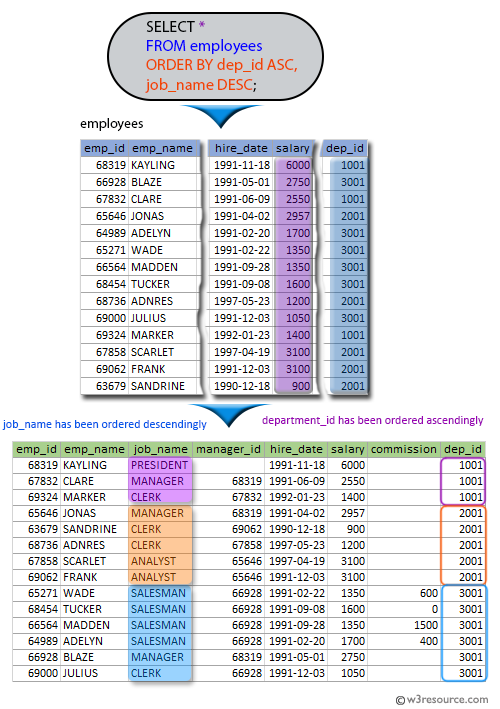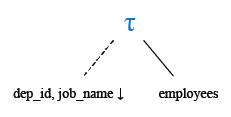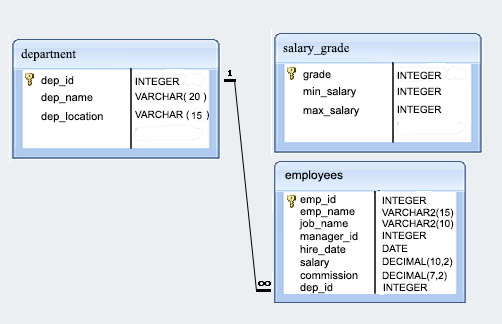SQL Exercise: Employees in ascending and descending order
[An editor is available at the bottom of the page to write and execute the scripts.]
67. From the following table, write a SQL query to list employees in ascending order on department ID and descending order on jobs. Return complete information about the employees.
Pictorial Presentation:
Sample table: employees
Sample Solution:
SELECT *
FROM employees
ORDER BY dep_id ASC,
job_name DESC;
Sample Output:
emp_id | emp_name | job_name | manager_id | hire_date | salary | commission | dep_id --------+----------+-----------+------------+------------+---------+------------+-------- 68319 | KAYLING | PRESIDENT | | 1991-11-18 | 6000.00 | | 1001 67832 | CLARE | MANAGER | 68319 | 1991-06-09 | 2550.00 | | 1001 69324 | MARKER | CLERK | 67832 | 1992-01-23 | 1400.00 | | 1001 65646 | JONAS | MANAGER | 68319 | 1991-04-02 | 2957.00 | | 2001 63679 | SANDRINE | CLERK | 69062 | 1990-12-18 | 900.00 | | 2001 68736 | ADNRES | CLERK | 67858 | 1997-05-23 | 1200.00 | | 2001 69062 | FRANK | ANALYST | 65646 | 1991-12-03 | 3100.00 | | 2001 67858 | SCARLET | ANALYST | 65646 | 1997-04-19 | 3100.00 | | 2001 65271 | WADE | SALESMAN | 66928 | 1991-02-22 | 1350.00 | 600.00 | 3001 64989 | ADELYN | SALESMAN | 66928 | 1991-02-20 | 1700.00 | 400.00 | 3001 66564 | MADDEN | SALESMAN | 66928 | 1991-09-28 | 1350.00 | 1500.00 | 3001 68454 | TUCKER | SALESMAN | 66928 | 1991-09-08 | 1600.00 | 0.00 | 3001 66928 | BLAZE | MANAGER | 68319 | 1991-05-01 | 2750.00 | | 3001 69000 | JULIUS | CLERK | 66928 | 1991-12-03 | 1050.00 | | 3001 (14 rows)
Explanation:
The said query in SQL that retrieves all the rows from the 'employees' table and order them first by the "dep_id" column in ascending order, and then by the "job_name" column in descending order.
This means that the employee records will be grouped first by department ID in ascending order, and within each department, the records will be ordered by job name in descending order.
Relational Algebra Expression:
Relational Algebra Tree:
Go to:
PREV : List the employees in ascending order of their salaries.
NEXT : Display all the unique job in descending order.
Practice Online
Sample Database: employees
Have another way to solve this solution? Contribute your code (and comments) through Disqus.
What is the difficulty level of this exercise?
Test your Programming skills with w3resource's quiz.



